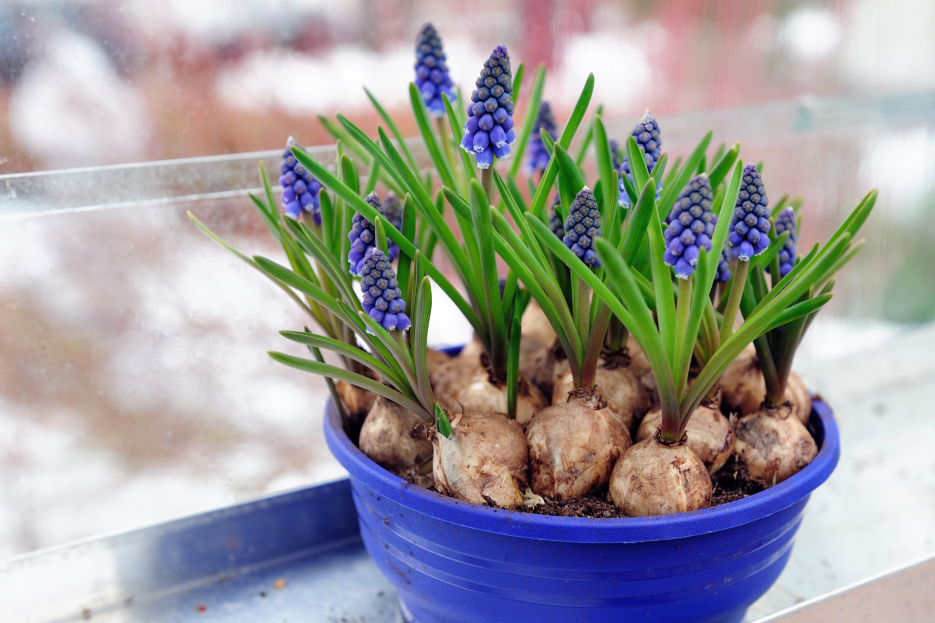
Muscari, commonly known as grape hyacinth, is a charming and fragrant flowering plant that can add a burst of color to any indoor space. With its small, bell-shaped flowers that resemble clusters of grapes, Muscari is a popular choice for gardeners and houseplant enthusiasts alike. These hardy plants are easy to care for and thrive with a little attention. Here’s how to care for your Muscari houseplant and enjoy its beautiful blooms year after year.
Muscari plants thrive in bright, indirect light. Place your Muscari near a sunny window where it can receive several hours of light each day. However, avoid direct sunlight, as it can scorch the delicate flowers and leaves. If possible, provide the plant with a location that gets morning sunlight and afternoon shade. This will help promote healthy growth and vibrant blooms.
Muscari plants prefer moderate moisture. Water your Muscari when the top inch of soil feels dry to the touch. Be sure to water thoroughly, allowing excess water to drain out of the pot. Muscari plants do not like to sit in water, so ensure that your pot has good drainage to prevent root rot. Avoid overwatering your plant, as this can cause the bulbs to rot. During the dormant period (after blooming), reduce watering and allow the soil to dry out slightly between waterings.
Muscari plants generally do well in average indoor humidity levels. They do not require high humidity, but they will benefit from occasional misting if your home is particularly dry. Be sure not to mist the flowers directly, as this can cause them to wilt or develop mold. A humidity tray placed beneath the plant can also help maintain a comfortable moisture level in the air.
Muscari prefers well-draining soil that retains some moisture but doesn’t become soggy. A standard potting mix combined with perlite or sand is ideal for growing Muscari indoors. The soil should have a slightly acidic to neutral pH, which is perfect for these plants. Make sure the pot you choose has drainage holes to avoid water accumulation at the bottom, which could lead to root rot.
Muscari plants thrive in cool to moderate temperatures. They prefer temperatures between 50-65°F (10-18°C) during the growing season. A cool environment will help the plant bloom well and last longer. Keep the plant away from hot spots, such as near radiators, air conditioners, or heating vents, as this can cause the flowers to wilt prematurely. If you can provide a cooler environment, your Muscari will thrive and bloom beautifully.
Muscari does not require heavy fertilization. You can feed your plant with a balanced, water-soluble fertilizer once every 4-6 weeks during the growing season (spring). Be sure to dilute the fertilizer to half strength to avoid overfeeding, which can harm the plant. After the blooming period, reduce or stop fertilizing, as the plant will be entering its dormant phase.
Once your Muscari plant has finished blooming, you can remove the spent flowers to prevent the plant from putting energy into seed production. However, it’s important to leave the foliage intact until it begins to yellow and die back naturally. The leaves help the plant store energy in the bulb for the next growing season. Cutting the leaves too early can reduce the plant's ability to bloom again in the future.
Muscari plants are typically grown from bulbs, and they do not require frequent repotting. If you are forcing Muscari to bloom indoors, you can repot the bulbs into fresh soil after blooming. However, many people choose to treat Muscari as an annual houseplant, discarding the bulbs after blooming and planting new ones each season. If you decide to keep the bulbs, allow them to rest in a cool, dry place for several months before replanting them in fresh soil.
Muscari plants are non-toxic to pets, making them a great option for households with cats and dogs. However, it’s still a good idea to discourage pets from nibbling on the leaves or flowers, as eating large amounts of any plant material can cause mild digestive upset.